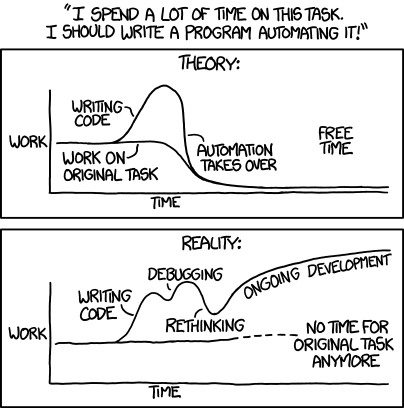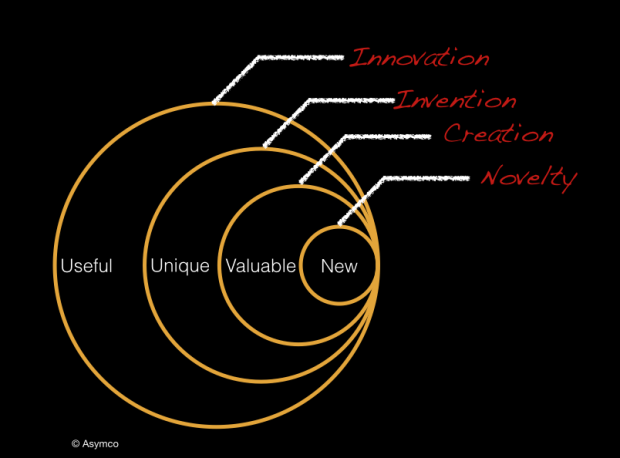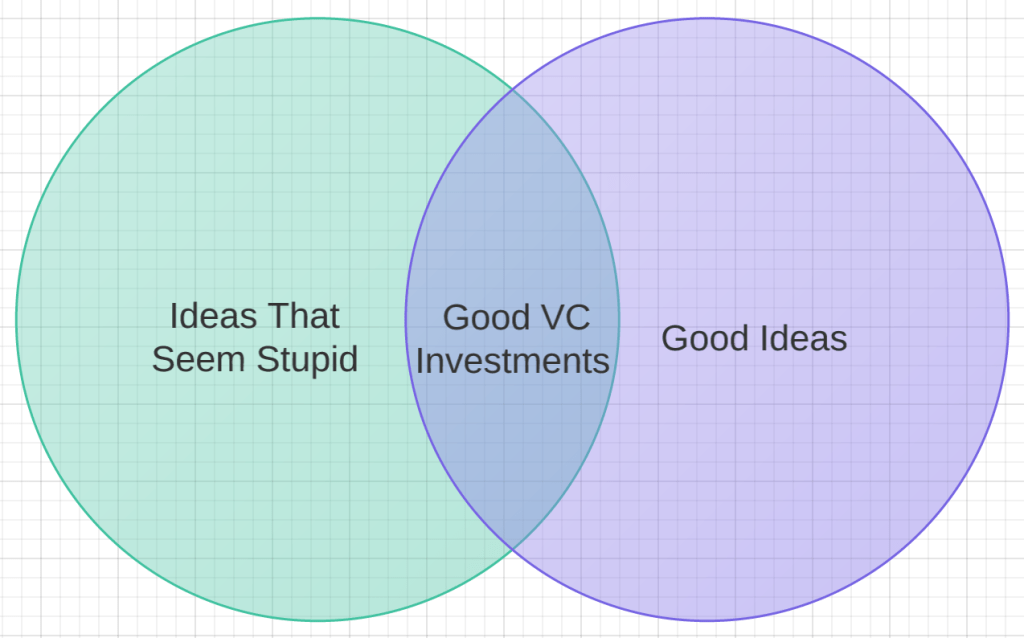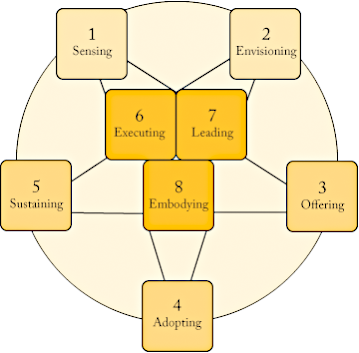Innovation is about finding a better way of doing something. Like many of the new development buzzwords (which many of them are over-used on many business documents), the concept of innovation originates from the world of business. It refers to the generation of new products through the process of creative entrepreneurship, putting it into production, and diffusing it more widely through increased sales. Innovation can be viewed as t he application of better solutions that meet new requirements, in-articulated needs, or existing market needs. This is accomplished through more effective products, processes, services, technologies, or ideas that are readily available to markets, governments and society. The term innovation can be defined as something original and, as a consequence, new, that “breaks into” the market or society.
Innoveracy: Misunderstanding Innovation article points out that there is a form of ignorance which seems to be universal: the inability to understand the concept and role of innovation. The way this is exhibited is in the misuse of the term and the inability to discern the difference between novelty, creation, invention and innovation. The result is a failure to understand the causes of success and failure in business and hence the conditions that lead to economic growth. The definition of innovation is easy to find but it seems to be hard to understand. Here is a simple taxonomy of related activities that put innovation in context:
- Novelty: Something new
- Creation: Something new and valuable
- Invention: Something new, having potential value through utility
- Innovation: Something new and uniquely useful
The taxonomy is illustrated with the following diagram.
The differences are also evident in the mechanisms that exist to protect the works: Novelties are usually not protectable, Creations are protected by copyright or trademark, Inventions can be protected for a limited time through patents (or kept secret) and Innovations can be protected through market competition but are not defensible through legal means.
Innovation is a lot of talked about nowdays as essential to businesses to do. Is innovation essential for development work? article tells that innovation has become central to the way development organisations go about their work. In November 2011, Bill Gates told the G20 that innovation was the key to development. Donors increasingly stress innovation as a key condition for funding, and many civil society organisations emphasise that innovation is central to the work they do.
Some innovation ideas are pretty simple, and some are much more complicated and even sound crazy when heard first. The is place for crazy sounding ideas: venture capitalists are gravely concerned that the tech startups they’re investing in just aren’t crazy enough:
Not all development problems require new solutions, sometimes you just need to use old things in a slightly new way. Development innovations may involve devising technology (such as a nanotech water treatment kit), creating a new approach (such as microfinance), finding a better way of delivering public services (such as one-stop egovernment service centres), identifying ways of working with communities (such as participation), or generating a management technique (such as organisation learning).
Theorists of innovation identify innovation itself as a brief moment of creativity, to be followed by the main routine work of producing and selling the innovation. When it comes to development, things are more complicated. Innovation needs to be viewed as tool, not master. Innovation is a process, not a one time event. Genuine innovation is valuable but rare.
There are many views on the innovation and innvation process. I try to collect together there some views I have found on-line. Hopefully they help you more than confuze. Managing complexity and reducing risk article has this drawing which I think pretty well describes innovation as done in product development:
8 essential practices of successful innovation from The Innovator’s Way shows essential practices in innovation process. Those practices are all integrated into a non-sequential, coherent whole and style in the person of the innovator.
In the IT work there is lots of work where a little thinking can be a source of innovation. Automating IT processes can be a huge time saver or it can fail depending on situation. XKCD comic strip Automation as illustrates this:

System integration is a critical element in project design article has an interesting project cost influence graphic. The recommendation is to involve a system integrator early in project design to help ensure high-quality projects that satisfy project requirements. Of course this article tries to market system integration services, but has also valid points to consider.
Core Contributor Loop (CTTDC) from Art Journal blog posting Blog Is The New Black tries to link inventing an idea to theory of entrepreneurship. It is essential to tune the engine by making improvements in product, marketing, code, design and operations.






5,158 Comments
Tomi Engdahl says:
“According to the U.S. Department of Education, 54% of U.S. adults 16-74 years old – about 130 million people – lack proficiency in literacy, reading below the equivalent of a sixth-grade level. That’s a shocking number for several reasons, and its dollars and cents implications are enormous because literacy is correlated with several important outcomes such as personal income, employment levels, health, and overall economic growth.”
https://readabilitymatters.org/articles/cost-of-low-adult-literacy
Tomi Engdahl says:
Here’s why it works.
Google’s ’20% rule’ shows exactly how much time you should spend learning new skills—and why it works
https://www.cnbc.com/2021/12/16/google-20-percent-rule-shows-exactly-how-much-time-you-should-spend-learning-new-skills.html?utm_content=Main&utm_medium=Social&utm_source=Facebook#Echobox=1677276492
Most people spend every second of their workday trying to keep up with their calendars and to-do lists — attending meetings, responding to emails, racing to meet deadlines.
This makes it difficult to set aside time to explore ideas that interest us or learn new skills. And during a time when it’s impossible to predict how our jobs and industries will evolve, expanding our expertise is what gives us a competitive edge in the long-run.
How can we ensure we make the time to stay ahead?
Enter: Google’s “20% time” rule, a concept made popular when Google went public in 2004.
“We encourage our employees, in addition to their regular projects, to spend 20% of their time working on what they think will most benefit Google,” founders Sergey Brin and Larry Page wrote in their IPO letter. “This empowers them to be more creative and innovative. Many of our significant advances [like AdSense and Google News] have happened in this manner.”
Sure, it’s easier said than done, but no one is going to hand you development opportunities on a platter; you need to seek them out proactively.
Here’s how:
1. Clearly identify what you want to learn
The key here is to be as specific as possible about what skill you want to build. So instead of taking 10 courses on 10 different topics, develop mastery in just one.
You’ll see faster improvement over time, which will motivate you to continue. And genuine expertise
2. Win — even if you lose
This is the ultimate way to make sure your 20% time doesn’t go to waste. Figure out the minimum benefit you’ll get out of a given situation or opportunity, even if nothing else breaks your way.
It might be exposure to a new industry, making connections in a different region, or practicing valuable skills like public speaking and clear communication.
If the minimal outcome alone sounds intriguing, then the project is likely a good bet.
3. Be flexible and committed
Protecting your 20% time is like maintaining a diet: It’s good to be disciplined, but sometimes you need to bend the rules and be flexible.
Client emergencies or impromptu staff meetings may prevent you from spending the time you’ve allocated in your calendar, and that’s okay — as long as you make a point to reschedule it and keep that commitment.
The point isn’t that you have to do your 20% time every Thursday afternoon; the point is to do it, period.
4. Look for ways to make it fun
It takes effort guard your 20% time, and it’s a lot harder to maintain that willpower if all you’re doing is endless homework and rigorous training sessions.
You may need a hardcore dose of that willpower periodically because in any discipline, there are some challenging elements you’ll have to master.
5. Think in decades
Just like with an investment in the stock market, when you invest time in your 20% projects, the power of compound interest is dramatic. What at first seems small and meaningless can enable you to put massive distance between you and your competitors.
Tomi Engdahl says:
Scientists Say They Can Reverse Time in a Quantum System
“We can rewind to a previous scene or skip several scenes ahead.”
https://futurism.com/scientists-reverse-time-quantum
In a series of six papers, the team from the Austrian Academy of Sciences and the University of Vienna detailed their findings. The familiar laws of physics don’t map intuitively onto the subatomic world, which is made up of quantum particles called qubits that can technically exist in more than one state simultaneously, a phenomenon known as quantum entanglement.
Now, the researchers say they’ve figured out how to turn these quantum particles’ clocks forward and backward.
“In a theater, [classical physics], a movie is projected from beginning to end, regardless of what the audience wants,” Miguel Navascués, a researcher at the Austrian Academy of Sciences’ Institute of Quantum Optics and Quantum Information who worked on the research, told El País.
“But at home [the quantum world], we have a remote control to manipulate the movie,” he added. “We can rewind to a previous scene or skip several scenes ahead.”
“We have made science fiction come true!” the researcher exclaimed.
By developing a “rewind protocol,” the team says they were able to revert an electron to a previous state. In experiments, they say they were able to demonstrate the use of a quantum switch to revert a photon to its original state before passing through a crystal.
While it’s an exciting prospect, scaling up the technique could prove extremely difficult, if not impossible.
“Also, the time needed to complete the process depends on the amount of information the system can store,” Navascués added. “A human being is a physical system that contains an enormous amount of information. It would take millions of years to rejuvenate a person for less than a second, so it doesn’t make sense.”
Besides, the system is only able to revert the state of a given particle. To speed up time, though, the researchers have an ace up their sleeves.
Tomi Engdahl says:
https://phys.org/news/2023-02-physicists-law-thermodynamics-makeover.html
Tomi Engdahl says:
Uh, James Webb Found Some Galaxies That Technically Shouldn’t Exist
And now we’re rethinking what we know about the ancient universe.
https://www.popularmechanics.com/space/deep-space/a43026293/jwst-discovers-impossible-galaxies/
Tomi Engdahl says:
Aivotutkijan mielestä ihmisten pitäisi ehdottomasti saada elämäänsä lisää tyhjää tilaa kännykän näpräämisen sijaan.
Nykyihmisen käytös huolestuttaa aivotutkijaa – Saa monen aivot huutamaan punaista
https://www.iltalehti.fi/terveysuutiset/a/f506ede8-5505-4eb3-8706-c9d8e44b8733?utm_medium=Social&utm_source=Facebook#Echobox=1677559250
Elämänhallinnan kannalta tarvitsemme lisää hidasta tekemistä kännykän näpräämisen sijaan.
Sosiaalinen media, erilaiset sovellukset ja mainokset kilpailevat koko ajan huomiostamme. Moni kuuntelee jo äänikirjojakin nopeutettuna.
Mutta tarvitseeko jo valmiiksi infoähkystä kärsivien tehostaa jokaista elämän osa-aluetta vaikkapa nopeutettuna kirjan kuunteluna? Eikö ennemmin tulisi opetella rauhoittumaan ja rauhoittamaan tekemisiämme?
– Siitä olen ihan samaa mieltä, professori, aivotutkija Minna Huotilainen aloittaa.
– Mutta tässä on oikeastaan kaksi asiaa. Mikä on tiedonhankinnan kannalta kätevää ja mikä on taas elämänhallinnan kannalta hyväksi ihmiselle, hän sanoo.
– Isoin ryhmä, jolla on kokemusta sisällön kuuntelemisesta nopeutettuna, ovat näkövammaiset. He ovat jo vuosikymmeniä kuunnelleet nopeutettuna esimerkiksi sanomalehtiä. Eli se on tottumiskysymys, millä tavalla ihminen pystyy oppimaan. Mutta silloin on kysymys tiedonhausta, ei esimerkiksi rentoutumisesta, Huotilainen painottaa.
Aikaa tehdä ”ei mitään”
Elämänhallinnan kannalta tarvitsemme hidasta tekemistä, eikä nopeutettua kirjan kuuntelua.
– Kiireinen ihminen tarvitsee aikaa, jolloin ei oikeastaan tehdä yhtään mitään ja mieli ei ota vastaan mieletöntä informaatiotulvaa. Vaikkapa astianpesukoneen tyhjennys tai koiran ulkoiluttaminen ovat tekemistä, jotka eivät vaadi aivoiltamme valtavaa, jatkuvaa uuden tiedon käsittelyä, Huotilainen vinkkaa.
– Niitä hetkiä meidän elämä tarvitsee lisää, eikä mitään nopeutettua kirjan kuuntelua.
Huotilaisen mukaan ihmisten pitäisi ehdottomasti saada elämäänsä lisää tyhjää tilaa.
Me elämme ensimmäistä kertaa maailmanhistoriassa aikaa, jolloin on mahdollisuus täyttää kaikki tyhjät hetket jollakin.
– Vielä muutama vuosi sitten ihmiset kantoivat ehkä sitä iltapäivälehteä mukanaan, ettei tule bussissa tylsää. Mutta nyt meillä on ihan koko ajan kädessä puhelin täynnä todella kiinnostavia juttuja, jatkuvaa uutisvirtaa ja somesisältöjä. Se on kyllä uusi tilanne, eikä me ihan tiedetä, miten sen kanssa pitäisi toimia, Huotilainen sanoo.
– Ei ole kyllä optimaalinen tilanne, että me täytämme kaiken mahdollisen ajan elämästä netin tarjoamalla sisällöllä.
Huotilainen vertaa tilannetta vallitsevaan ylipaino-ongelmaan.
Tomi Engdahl says:
Mullistava löytö Maapallon ytimestä – Tällainen on valtava ”metallipallo”
Maapallon kiinteä sisäydin suojelee meitä ulkoavaruuden tappavalta kosmiselta säteilyltä
https://www.iltalehti.fi/ulkomaat/a/abeee587-b4a9-41d6-92e6-0fc0f671e23a
Australian kansallisen yliopiston tutkijat ovat löytäneet uutta todistusaineistoa maan ytimen sisällä sijaitsevasta ”metallipallosta”. Löydön uskotaan antavan vastauksia maan magneettikentän muodostumiseen. Tutkimuksesta uutisoi The Washington Post -lehti. Tutkimus julkaistiin Nature communications -lehdessä.
https://www.nature.com/articles/s41467-023-36074-2
Tomi Engdahl says:
RESEARCHERS SAY THEY MANAGED TO PULL QUANTUM ENERGY FROM A VACUUM
https://futurism.com/the-byte/researchers-quantum-energy-vacuum
A team of physicists claims to have pulled energy out of a vacuum, Quanta reports — a trick that required them to teleport it from a different location using quantum tech.
The work builds on previous research by Tohoku University theoretical physicist Masahiro Hotta, who back in 2008 claimed to have found a way to produce negative energy, a seemingly counterintuitive aspect of quantum theory, inside a quantum vacuum.
In simple terms, instead of extracting something from nothing, the energy was “borrowed” from somewhere else, taking advantage of the idea of quantum entanglement, the fact that two subatomic particles can change their state in line with the other, even when the two are separated by a distance.
Physicists Use Quantum Mechanics to Pull Energy out of Nothing
By
CHARLIE WOOD
February 22, 2023
https://www.quantamagazine.org/physicists-use-quantum-mechanics-to-pull-energy-out-of-nothing-20230222/
The quantum energy teleportation protocol was proposed in 2008 and largely ignored. Now two independent experiments have shown that it works.
Tomi Engdahl says:
SCIENTISTS DISCOVER GIGANTIC SOLID METAL BALL INSIDE THE EARTH’S CORE
https://futurism.com/the-byte/gigantic-metal-ball-earth-core
Tomi Engdahl says:
Inside the lab that’s growing mushroom computers
The lead researcher says he is “planning to make a brain from mushrooms.”
https://www.popsci.com/technology/unconventional-computing-lab-mushroom/
Tomi Engdahl says:
Scientists target ‘biocomputing’ breakthrough with use of human brain cells
Proposal for ‘intelligence in a dish’ that can efficiently perform advanced tasks raises ethical concerns
https://www.ft.com/content/9f51a30d-eedc-446a-8a5c-d2997c670c65
Tomi Engdahl says:
Mullistava löytö Maapallon ytimestä – Tällainen on valtava ”metallipallo”
Maapallon kiinteä sisäydin suojelee meitä ulkoavaruuden tappavalta kosmiselta säteilyltä
https://www.iltalehti.fi/ulkomaat/a/abeee587-b4a9-41d6-92e6-0fc0f671e23a
Tomi Engdahl says:
First measurements of hydrogen-boron fusion in a magnetically confined fusion plasma
https://phys.org/news/2023-02-hydrogen-boron-fusion-magnetically-confined-plasma.html
Tomi Engdahl says:
LYHYESTI TIETEESTÄ: SÄHKÖKERAAMIT
Alempaan ja alempaan valmistuslämpötilaan
Professori Jantusen tutkimusryhmä on ensimmäisenä maailmassa tehnyt 3D-tulostetun keraamikappaleen ilman lämpökäsittelyä.
https://tekniikanmaailma.fi/lehti/4b-2023/alempaan-ja-alempaan-valmistuslampotilaan/#Echobox=1677575289
Tomi Engdahl says:
Up-to-fivefold reverberating waves through the Earth’s center and distinctly anisotropic innermost inner core
https://www.nature.com/articles/s41467-023-36074-2
Tomi Engdahl says:
Millaista teknologiaa on syönyt Sakon tarkkuuskivääri, jonka kantama on jopa 1 400 metriä?
https://tekniikanmaailma.fi/millaista-teknologiaa-on-syonyt-sakon-tarkkuuskivaari-jonka-kantama-on-jopa-1400-metria/
Tomi Engdahl says:
MIT Spins Qubits Round And Round
https://hackaday.com/2023/02/16/mit-spins-qubits-round-and-round/
Tomi Engdahl says:
Quantum Interconnects Get Faster
https://hackaday.com/2023/02/17/quantum-interconnects-get-faster/
Tomi Engdahl says:
IBM Wants You To Learn Tech
https://hackaday.com/2023/02/22/ibm-wants-you-to-learn-tech/
IBM — no stranger to anyone who works in the computing field — has launched a series of training modules on a site called skillsbuild.org. The site targets high school students, college students, and adult learners and offers tracks for jobs like cybersecurity analyst, IT support technician, Web developer, and data science. Several other companies are participating, such as Red Hat and Fortinet. The cost? The courses are free and you can earn digital credentials to show you’ve completed certain classes.
Even more interesting is that they have resources for schools and other organizations that want to leverage the material for students. There is even software that educators can download at no charge for classroom use. The material is available in a variety of languages, too. For more advanced topics, there’s also Cognitive class from IBM, also free and which also provides the same sort of credentials.
Kick-start your tech journey with free courses and resources.
https://skillsbuild.org/learners
Tomi Engdahl says:
Simultaneous Invention, All The Time?
https://hackaday.com/2023/02/25/simultaneous-invention-all-the-time/
Tomi Engdahl says:
https://hackaday.com/2023/02/26/the-last-meccano-factory-is-to-close-will-we-miss-it/
Tomi Engdahl says:
https://hackaday.com/2023/02/28/move-over-steel-carbon-reinforced-concrete-is-here/
Tomi Engdahl says:
Researchers have demonstrated that bioelectronics can be made directly inside the brains of live animals by injecting a cocktail of molecules that can transform into electrically conductive gel.
Growing Electronics Inside the Brain
https://spectrum.ieee.org/brain-computer-interface?share_id=7498990&socialux=facebook&utm_campaign=RebelMouse&utm_content=IEEE+Spectrum&utm_medium=social&utm_source=facebook
Experiments in live zebrafish and leeches may one day lead to growing microchips in living tissue
Bioelectronics can be made directly inside the brains of live animals by injecting a cocktail of molecules that can transform into electrically conductive gel, a new study finds.
Scientists have created bioelectronics in live zebrafish and leeches with this new technique. In the long term, the ability to turn any living tissue into electronic matter could make it possible to fabricate microchips in live organisms, the researchers say.
By taking advantage of how neurons operate using electrical signals, electronics can interact with brains and nerves to analyze their activity or treat injuries and disorders. However, bodily tissues are mostly soft and flexible, whereas bioelectronic implants are typically hard and rigid. This mismatch can damage the body, which may harm patients and impair the devices.
In the new study, researchers developed a way to fabricate soft, flexible bioelectronics directly within biological tissue.
Tomi Engdahl says:
https://www.iflscience.com/elementary-school-students-discover-epipens-turn-extremely-poisonous-in-space-67776
Tomi Engdahl says:
REGULATORS REPORTEDLY REJECTED ELON MUSK’S APPLICATION TO TEST BRAIN CHIPS IN HUMANS
“HE CAN’T APPRECIATE THAT THIS IS NOT A CAR. THIS IS A PERSON’S BRAIN. THIS IS NOT A TOY.”
https://futurism.com/neoscope/regulators-rejected-elon-musk-application-brain-chips-humans
Tomi Engdahl says:
https://futurism.com/the-byte/dinosaurs-face-complete-with-its-skin
Tomi Engdahl says:
https://futurism.com/the-byte/controlling-where-lightning-strikes-lasers
Tomi Engdahl says:
MIT INVENTS “X-RAY VISION” HEADSET THAT CAN SEE INSIDE BOXES
https://futurism.com/the-byte/mit-headset-find-objects
Tomi Engdahl says:
SCIENTISTS SAY THEY’VE DEVISED A WAY TO 3D PRINT INSIDE THE HUMAN BODY
THIS TINY DEVICE COULD BE A GAME CHANGER.
https://futurism.com/neoscope/scientists-3d-print-inside-human-body
Tomi Engdahl says:
Black holes destroy nearby quantum superpositions, thought experiment reveals
https://physicsworld.com/a/black-holes-destroy-nearby-quantum-superpositions-thought-experiment-reveals/
Tomi Engdahl says:
Scientists Find Nearby Planet the Same Size of Earth, Plan to Search It for Life
The conditions are perfect — almost.
https://futurism.com/nearby-planet-size-earth-search-life
A team of astronomers has discovered a highly intriguing rocky planet orbiting in the habitable zone of a nearby star.
Since it orbits its star at a distance where liquid water can exist, the scientists say they’re excited to probe the Earth-like planet for signs of extraterrestrial life.
Tomi Engdahl says:
https://www.popsci.com/health/what-is-non-alcoholic-beer/
Tomi Engdahl says:
https://phys.org/news/2023-02-theoretical-cooling-particles-laser-fields.html
Tomi Engdahl says:
An Applied Mathematician With an Unexpected Toolbox
By
RACHEL CROWELL
March 1, 2023
Lek-Heng Lim uses tools from algebra, geometry and topology to answer questions in machine learning.
https://www.quantamagazine.org/an-applied-mathematician-strengthens-ai-with-pure-math-20230301/
Tomi Engdahl says:
Solar breakthrough paves way for first ‘miracle material’ panels
Perovskite is vastly more efficient than silicon at absorbing sunlight, but until now has been too unstable for commercial use
https://www.independent.co.uk/tech/solar-power-perovskite-renewable-energy-b2290451.html#Echobox=1677513766
Tomi Engdahl says:
Lab-grown minibrains will be used as ‘biological hardware’ to create new biocomputers, scientists propose
By Ben Turner published 4 days ago
A new proposal suggests using stem cell-derived ‘minibrains’ to create brand-new biocomputers. Such ‘organoid computers’ could be far off, but ethical questions abound.
https://www.livescience.com/lab-grown-minibrains-will-be-used-as-biological-hardware-to-create-new-biocomputers-scientists-propose
Tomi Engdahl says:
Scientists Now Want to Create AI Using Real Human Brain Cells
Move over artificial intelligence, say hello to “organoid intelligence” (OI).
https://www.vice.com/en/article/qjkgap/scientists-now-want-to-create-ai-using-real-human-brain-cells
Tomi Engdahl says:
SCIENTISTS WORKING TO BUILD BIOCOMPUTERS OUT OF LAB-GROWN “MINIBRAINS”
“WHILE SILICON-BASED COMPUTERS ARE CERTAINLY BETTER WITH NUMBERS, BRAINS ARE BETTER AT LEARNING.”
https://futurism.com/neoscope/scientists-biocomputers-lab-grown-minibrains
Tomi Engdahl says:
https://arstechnica.com/science/2023/03/is-the-future-of-computing-biological/
Tomi Engdahl says:
Kombucha cultures can be turned into flexible electric circuit boards
https://www.newscientist.com/article/2358806-kombucha-cultures-can-be-turned-into-flexible-electric-circuit-boards/#Echobox=1677264738
The congealed mat of yeast and bacteria cells that forms on top of the brewed drink kombucha could be used to make light, cheap and flexible circuit boards for wearable electronics or even partially living rudimentary computers
Tomi Engdahl says:
https://futurism.com/the-byte/nasa-ryugu-sample-building-blocks-life
Tomi Engdahl says:
IEEE Spectrum ran a really interesting article on the huge shadow cast by the famous Xerox Alto. It’s pretty amazing when you think about how much of the Alto’s design, which dates from 1973, is still in use today. Pretty much every element of modern UI design, from windows to file management systems to even the physical “keyboard-mouse-monitor on the desk, box on the floor” arrangement, traces directly back to the Alto — about the only thing Alto got wrong is that most of us don’t use monitors in portrait mode.
50 Years Later, We’re Still Living in the Xerox Alto’s World
The Alto transformed computing. And the changes stuck
https://spectrum.ieee.org/xerox-alto
Rather, it’s half-century-old hardware running software of the same vintage, meticulously restored and in operation at the Computer History Museum’s archive center. Despite its age, using it feels so familiar and natural that it’s sometimes difficult to appreciate just how extraordinary, how different it was when it first appeared.
I’m talking about the Xerox Alto, which debuted in the early spring of 1973 at the photocopying giant’s newly established R&D laboratory, the Palo Alto Research Center (PARC). The reason it is so uncannily familiar today is simple: We are now living in a world of computing that the Alto created.
The Alto was a wild departure from the computers that preceded it. It was built to tuck under a desk, with its monitor, keyboard, and mouse on top. It was totally interactive, responding directly to its single user.
The computer, and the office, of the future
Broadly speaking, the PARC researchers set out to explore possible technologies for use in what Xerox had tagged “the office of the future.” They aimed to develop the kind of computing hardware and software that they thought could be both technologically and economically possible, desirable, and, perhaps to a lesser extent, profitable in about 10 to 15 years.
The type of computing they envisioned was thoroughly interactive and personal, comprehensively networked, and completely graphical—with high-resolution screens and high-quality print output.
Tomi Engdahl says:
The First Gui? Volscan Controls The Air
https://hackaday.com/2023/03/09/the-first-gui-volscan-controls-the-air/
In the 1950s, computers were, for the most part, ponderous machines. But one machine offered a glimpse of the future. The Volscan was probably the first real air traffic computer designed to handle high volumes of military aircraft operations. It used a light gun that looked more like a soldering gun than a computer input device. There isn’t much data about Volscan, but it appears to have been before its time, and had arguably the first GUI on a computer system ever.
Tomi Engdahl says:
https://arstechnica.com/science/2019/11/these-rats-learned-to-drive-tiny-cars-for-science/
Tomi Engdahl says:
https://futurism.com/the-byte/enzyme-turn-air-into-electricity
Tomi Engdahl says:
Scientists discover superconducting material that could bring total revolution in energy and electronics
Previous similar study drew scepticism – but scientists say they have now proven that and more
https://www.independent.co.uk/tech/superconducter-material-breakthrough-energy-electronics-b2297855.html
Tomi Engdahl says:
https://tekniikanmaailma.fi/lehti/5b-2023/ratkesiko-pimean-energian-arvoitus-nyt/
Tomi Engdahl says:
https://futurism.com/the-byte/water-existed-before-solar-system
Tomi Engdahl says:
Scientists have developed a ‘living PC’ made from mushrooms
Mycelia could form the architecture of future computer brain interfaces
https://www.techspot.com/news/97836-scientist-have-developed-living-pc-made-mushrooms.html
Tomi Engdahl says:
https://www.independent.co.uk/tech/electricity-from-thin-air-enzyme-clean-energy-b2297860.html#Echobox=1678292004